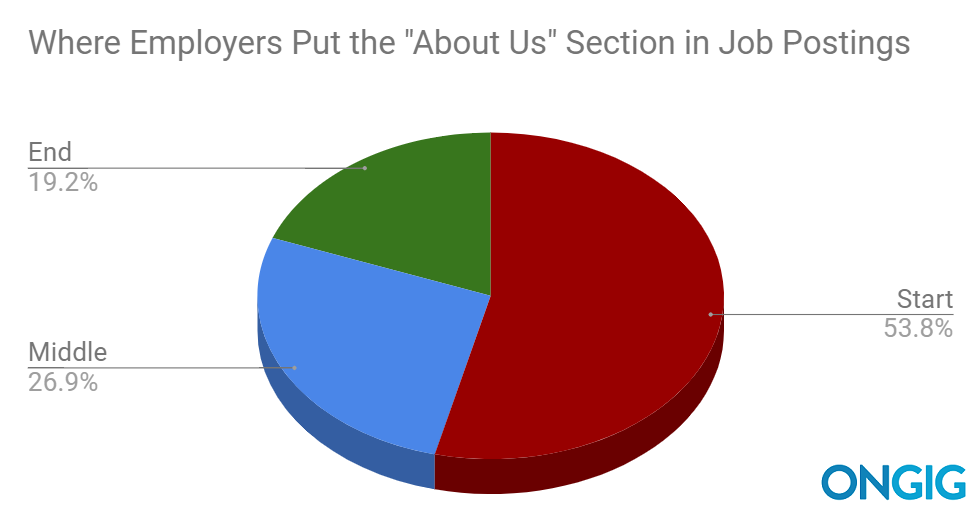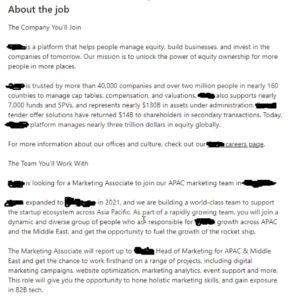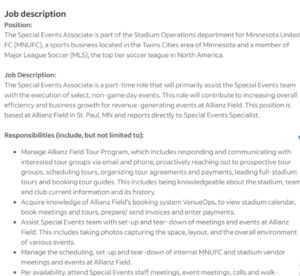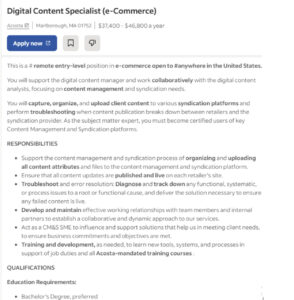- What’s the Difference Between a Job Description, Job Posting, and Job Ad - June 5, 2025
- Top 20+ Diversity Equity Inclusion Titles (with Descriptions) 2024 - October 18, 2024
- A List of Common Offensive (Exclusionary) Words Used in Job Descriptions (2024) - October 18, 2024
Where should your “About Us” section go in a job posting? The start? The middle? The end? If you guessed the start, you’re not alone, but you might be in for a surprise about its effectiveness.
An informal survey of job postings on Indeed, Glassdoor, and Google for Jobs shows that 53.8% of employers start their postings with About Us.
The next most common placement (26.9%) of job postings have the About Us somewhere in the middle (often in the 2nd or 3rd paragraph). The rest (19.2%) put About Us at the end.
So, what’s optimal?

Research shows that candidates spend an average of 49.7 seconds skimming applications before they decide if a position suits them.
So, where’s the best part of your JD posting page design to position your about us section? Before we answer that question, we should take a quick look at a growing trend among talent acquisition experts: their emerging roles as business leaders.
Modern Talent Acquisition Experts As Business Leaders
The post-pandemic workforce disruptions and economic uncertainties have required talent acquisition experts to innovate.
Finding the right people for the right jobs was no longer simply about job placements. Talent acquisition teams increasingly need to understand their enterprise’s long-term needs and workflow. Essentially, this plays an active part in business intelligence initiatives.
That meant recruiters had to learn new skills and competencies, like applying data-driven AI solutions that sped up the hiring process in the face of skill shortages.
Modern talent teams also focus on workforce planning and how hiring qualified candidates can lead to a more sustainable workforce against industry and market volatility.
How Does That Tie In With My About Us Section?
Your JD is a critical element in your hiring campaigns. How you structure your JD will determine application rates and the quality of hire (Qoh).
According to the ATS experts at Ashby, a well-structured JD narrative/story attracts and retains the right new hires.
To achieve a compelling job listing, your JD should convince candidates how they can stay motivated, have the confidence to perform in their role, and commit to their duties. Doing so keeps your workforce satisfied and prevents workforce attrition.
The About Us section is an important JD segment that highlights the uniqueness of your employer profile. It serves as a differentiator: why a candidate would pick your company and brand over the sea of competitors.
As such, optimizing the position of your About Us section could sway the opinions of candidates currently on the fence. But, it is necessary to first consider what candidates really want when they accept a job offer.
There’s More – The Job Market is Shifting
In recent years, employers have heard much chatter about terms like silent quitting and the great resignation.
These phenomena point to a candidate-driven job market where talent acquisition teams had to appease short-term job seeker trends. However, these may set to change within the year as the economy recovers while unemployment rates stabilize.
In other words, talent acquisition teams could see a shift toward an employer-driven market once more. The workforce trend is already in motion with the recent massive layoffs across industry-leading companies like Amazon and Hasbro.
However, an employee-driven market doesn’t mean companies should spend less effort in offering employee benefits or social policies like DEIB initiatives.
Rather, it could signal a crossroads to rethink your hiring and recruitment strategy. In past years, it was critical to present JDs that meet immediate employee demands to quickly increase application rates to fill roles.
Now, times have changed, and the workforce seem to move toward a talent acquisition landscape where candidates prioritize job sustainability. So, with quality JDs, it is about strategically presenting a position that offers candidates that assurance.
You want candidates to clearly understand their purpose and expected contributions to your company. Doing so enables them to decide whether the position offers workplace safety, financial security, and long-term career development.
That’s why it is often in your company’s best interest to position JD sections like salary range, benefits, and responsibilities at the top.
With the talent acquisition team’s roles as business leaders explained, we look deeper at why job postings are generally less effective when positioned as the opening hooks of JDs.
Why Beginning Your Job Postings with “About Us” is Often a Mistake
Essentially, there are 2 reasons that you don’t want to lead with an About Us section:
1) Candidates Put Their Self-Interest First
As we discussed in the previous section, candidates mainly focus on what’s in it for them. It’s a survival instinct. This mindset applies across employee and candidate-driven job markets. After all, humans were created with survivability in mind – there’s the perpetual question in everybody’s head – “What’s in it for me?” In psychology, this is called self-interest. It’s got economic roots too.
As Adam Smith, father of economics, once said (and I’m paraphrasing):
“Humans act rationally and in their own self-interest. Decisions are generally made based on financial prudence and intrinsic satisfaction.”
Below is an example of a job posting for a marketing associate position that starts with the about us section (i.e., The Company You’ll Join).

Do you notice how the first two paragraphs of the job posting focused on describing the company?
The JD could have left a stronger impression by swapping the “The Team You’ll Work With” and “The Company You’ll Join” sections.
It is crucial to consider every job ad from the perspective of the type of talent you wish to attract. For example, an aspiring marketing associate in an employer-driven job market might have the following thoughts in their head during their job search.
“Where can I join supportive marketing team members who allow me to contribute my skills and expertise toward a niche client? Who do I report to for my role, and what are my duties so I can stay highly productive, relevant, and continuously improve despite workforce uncertainties?”
The following is a great example by Minnesota United FC (MNUFC) of how JD positioning could improve website visitor traffic and increase job application rates.

The JD begins by explaining the details of the position and the work locations. The short description does not go into lengthy detail about the club’s illustrious career but rather introduces the hero of the story – the candidate, and their role in assisting the special events team.
Doing so establishes the position’s significance. These opening statements can resonate with job seekers looking for an opportunity to assist in major league soccer events.
“Special Events Associate” is a keyword in the opening sentence, making the JD more searchable by qualified and interested job seekers. The job description also gives applicants a sense of purpose by emphasizing that the role increases overall efficiency and business growth for revenue-generating events.
The JD below from the Acosta marketing group is another great example of prioritizing the candidate’s needs above all else. Acosta opens with an emboldened introduction that clearly presents a remote entry-level position, which caters to ongoing demands for workplace flexibility.
The strategically structured digital content specialist JD goes on to focus on the applicant’s contributions and their impact on the organizational workflow. In this case, the JD explicitly requires hires to troubleshoot syndication platform issues between retailers and providers.
Acosta follows up with key JD sections like responsibilities and qualifications to streamline the search for the perfect candidate. The JD concludes with the company’s equal opportunity employer (EEO statement) and about us sections.

Positioning Your Candidate As The Hero
You can significantly boost the candidate experience by making job seekers the hero of the story before disclosing your company’s background. As we will explain later, the latter would offer the perfect finishing touch to connect with your next star hire.
We highlighted the “candidate as hero” concept in The 5 Storytelling Steps to Transform Your Career Site. That’s where we explain how candidate-focused job titles and the media of smiling, satisfied employees empower your target candidate and improve their job-seeking experience.
Essentially, you, the talent leader/recruiter, should take a backseat to the candidate hero and serve as their guide. You’re Obi-Wan Kenobi/Yoda (guide) to Luke Skywalker (hero), Haymitch (the guide) to Katniss (the hero), or Dumbledore (guide) to Harry Potter (hero).
And if you’re not familiar with one of those stories, please take a short break from this blog and check out those classics!
2) Google Prioritizes Opening Paragraphs
You should reevaluate how you begin your job posting to increase candidate engagement from Google. According to SEO experts, it is critical to engage your target audience from the opening paragraph. Marketing teams use the same concept when engaging potential customers for a product or service.
There’s a content strategy term known as the core sentence, which summarizes your opening paragraph’s main points and affects the top of the page rankings for the search engine results page (SERP). The higher the ranking, the easier it is to attract your next big hire.
That’s because Google analyzes website content according to a reader’s perspective. In a sense, the search engine mimics human perception.
So, imagine a job seeker’s perspective and priorities when searching for a job online. While doing so, we should also consider the implications of an employer-driven job market.
The following questions could shape your idea of an attention-grabbing job listing.
Would your target candidate consider employer credentials and the company’s history over roles and value propositions that suit them? What are the relevant search keywords and phrases involved in the process? What type of assurance do they seek in their career positions?
Putting that into perspective:
- If you begin your job posting with an About Us statement, you show Google that your job posting is more about your company history than the job itself.
- If you’re looking for a software developer, and the phrase “software developer” is not in your opening paragraph, then Google is unlikely to send candidates to your job posting.
- All other things are equal. If you lead your job posting with an About Us section and your competitor leads with a role description, Google will send more traffic to your competitor.
With all things considered, starting a job listing with a less candidate-focused statement could divert your prospective candidates to opponents with better SEO-aligned openers!
Our Advice on “About Us” Placement?
With all that’s said, including the About Us section is a great way to promote your organization’s core values. It should appear after you’ve discussed all the details about the job and employee benefits.
Position the About Us section as your closing paragraph or toward the end.
Don’t get us wrong. Good candidates would love to read about your organization. They just want to read about you after they know what’s in it for THEM.
The Exceptions For When You Might Start a Job Posting with “About Us”
There are only two exceptions that come to mind where it seems feasible to open your job posting with an about us section.
The first exception is if you are currently redefining your brand story. Take Harley Davidson, for example. They added a line of electric bikes for kids. A strategic company description at the opening of their JD paves the way toward a broader talent pool.
In this case, the following opener could attract specific job seekers seeking exposure to a new niche market:
“You might know Harley Davidson. We’ve been a symbol of freedom and power for cowboys and cowgirls for 115 years. Well, we are now serving kids too and helping the environment with our newest line of electric bikes for kids.”
The second exception to repositioning your About Us section applies if you have an emerging, mission-oriented brand. For example, if your company’s mission is to clothe every poor person within a decade, you could encourage job applications with a sentence or two promoting your revolutionary goals.
A compelling mission statement offers candidates a sense of direction, especially if they currently have multiple offers. They should be able to quickly scan your mission statement to determine the team dynamics and performance standards required at work.
Disclaimer About Exceptions to The About Us Rule
Despite these exclusive use cases, you’d still want to dive into your role details within the third or fourth sentence. And aside from those two exceptions, most recruiters should insert the About Us section at the end of their job post.
As mentioned earlier in the article, your About Us section offers the perfect finishing touch to your job posting. Following up on the candidate-centric sections convinces talent to join your company culture.
Essentially, your about us statement contributes to your employer branding and promotes trust among candidates. Hires can gain a semblance of understanding of individual and team expectations, which also directly contributes to career sustainability.
We’ve curated 15 tactful About Us statements from various industries to optimize your company profile.
How to Balance Company Information
Integrating company information into your job postings is essential. However, starting with it isn’t always the best idea. Instead, there’s a better way to balance this information without overwhelming potential candidates right off the bat.
Highlighting the Job First
When candidates first land on your job posting, they’re usually more interested in what the job entails rather than the company itself. That’s why the first section of your job posting should focus on the role, key responsibilities, and what the candidate can expect day-to-day.
When you lead with this, you not only grab their attention but also set a good first impression. This approach helps you connect with those who are eager to know if the role aligns with their skills and career goals. So, once you’ve hooked them with the job details, it’s time to weave in your company information.
Introducing Your Company in a Natural Flow
The best way to introduce your company is to follow up with a brief, engaging description. This is where you can mention your company values, mission, and what makes your workplace unique. So, think of it as a value proposition that shows why your company is the right place for them to grow.
Instead of cramming all the details into the first page of the posting, consider adding a link to your About Us page. Here, candidates can explore your brand’s story and humble beginnings in more detail if they’re interested. This way, you provide all the important information without overwhelming them upfront.
Using Visual Elements and Social Proof
Incorporating visual elements like a YouTube video or a striking photo from your online store can make your company’s story more engaging. In addition, sharing case studies or blog posts that highlight your achievements or work culture also adds credibility.
Separate Pages for More Details
If you have more to say about your company, you can create a separate page dedicated to your brand identity and company values. This can also be the perfect place to share your personal story, testimonials, and page highlights that showcase your hard work and dedication.
For small business owners and small businesses, keeping the design simple with short paragraphs and clear headers is key. This ensures that website visitors and new customers can easily navigate your corporate website and find the contact information they need.
Making a Strong Impression
Incorporating company information into your job postings without leading with it is all about balance. So, start with the job details, then smoothly transition into who you are as a company. Use short blurbs, visual aspects, and links to page examples or case studies for those who want to dive deeper.
With this approach, you’ll create a lasting impression without losing the interest of your first-time readers. Remember, it’s all about making that first place connection, and sometimes, putting in that extra effort makes all the difference in attracting the right talent.
Take Your JD Structure to The Next Level With AI!
For an effective flow to structuring your JDs, check out Ongig’s The 10 Main Sections of a Job Description. We highlight the main components you should include in a blog to maximize candidate engagement.
Alternatively, you could tap on the Text Analyzer’s advanced algorithm that automatically accounts for every key section of an effective JD.
How Ongig Text Analyzer Works
The Text Analyzer makes it a breeze to structure and manage compelling job postings. You can effortlessly optimize your descriptions to gain the attention of your target demographic, including passive candidates.
Text Analyzer automates the following functions with minimal onboarding required:
- Standardizing your job description library based on the latest inclusivity and diversity practices.
- Generating and accounting for every important element in your JD, including your about us section.
- Boosting JD readability to win the SEO game. The AI-powered system also eliminates subtle exclusionary words that could offend and turn away talented hires.
- Accessing deep API insights from your job postings to understand what works so you can replicate the success of quality hiring/recruitment campaigns.
With the Text Analyzer in your corner, you can consistently enhance and scale your job descriptions, such as positioning the About Us section for optimal impact.
Closing Thoughts
Google has jumped on the AI bandwagon, as evidenced by the release of its advanced GA4 Analytics. The program leverages machine learning and predictive analyses to support more strategic website-building and audience engagement via smart insights.
In the wake of these AI advancements, optimizing your JDs with algorithm-based accuracy has become increasingly critical. This can significantly improve SEO, increase conversion rates, and boost talent acquisition ROI.
How will you tell your company’s perfect About Us story in the dawn of a data-centric and employer-driven job market?
Why I Wrote This?
Ongig’s optimizes your job descriptions to drive the best candidate experience. We achieve this through an advanced AI-supported process that refines your job listings across every touchpoint. Request a Text Analyzer demo to discover how your hiring team can confidently attract top-tier hires from a more inclusive and diversified talent pool!
Shout-Outs:
- Yoast – How to write clear and SEO-friendly paragraphs
- Tech Crunch – A comprehensive list of 2024 tech layoffs
- Indeed – Why a mission statement is important: uses and examples
- Indeed – Survey: How to Improve Your Job Postings to Attract Better Candidates
- Ashby – Quality of Hire: How to Measure & Meaningfully Improve Through Top of Funnel Pipeline
- Rudderstack – What are the New Features of Google Analytics 4 (GA4)?
